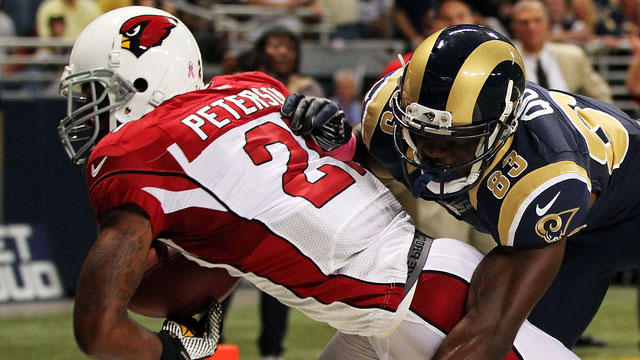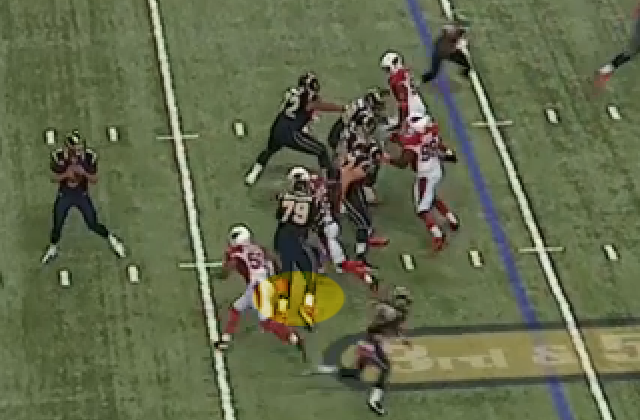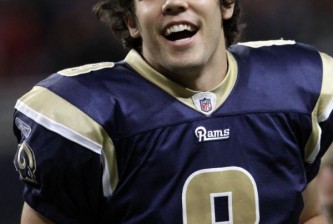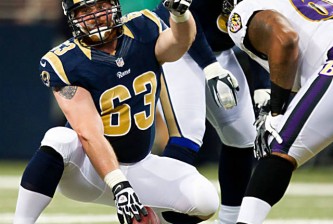
| Situation: | 3rd and 5 from the Arizona 16-yard line, with 6:39 left in the 3rd quarter, up 10-3 |
| Personnel: | 11 |
| Play: | Bunch Left Gun Right Y Buzz 980 F Dig / Flat, Brian Quick on a go route |
| Defense: | Cover 3 World, Weak Bullet |
Pre-Snap
Alignment Bunch Left Gun Right Y Buzz
The Rams come out in 11 personnel (1 back, 1 tight end) or sometimes referred to by an offense as nickel personnel. Bunch left part of the call tells us that there will be three receivers to the left, aligned tightly together. Given the formation and personnel that means the Y, Z, and F (tight end) receivers will be aligned to the left and the X receiver, here Brian Quick, here will be on the right. The “Gun Right” part of the call tells us that Bradford is in the gun with Richardson to his right of him.
“Y Buzz” is a motion tag. It sends the Y receiver, here Austin Pettis, to the side of the call and outside the widest receiver.
Offensive Playcall
As you may remember from last week, most teams use a three-digit numbering system to call pass plays. So 980 tells us the routes that the XYZ receivers will run.
X receiver, Brian Quick (83) will run a 9 route. A 9 route is a simple go or fade route. On this particular play Quick will have a mandatory outside release because the play is designed to go underneath of him. An inside release would allow the corner to keep his eyes inside and be able to defend Quick or come up and make a play on anything underneath of him.
Y receiver, Austin Pettis (18) will run an 8 route which is a post. Z receiver, Chris Givens (13) will run a 0 route, which is a shallow crossing route often referred to as a drag. The route is designed to be about 4-6 yards underneath the dropping linebackers.
Notice Givens’s alignment behind Lance Kendricks (88). This is known as a stack technique. Off the line Kendricks will clear out space, allowing Givens to have a free release off underneath of him. Kendricks has what is known as a dig route which is 10 yards straight up field, at 10 he begins to break for 2 yards to simulate a post route and then 2 yards into that the route becomes an in route. Daryl Richardson (26) has a flat route which is essentially a speed out.
Defense: Cover 3 World Weak Bullet
This is unique defensive look from the Cardinals. They have two defensive ends lined up inside. Outside linebackers, Sam Acho (94) and O’Brien Schofield (50) are stand-up defensive ends. This is their speed package. It’s similar to Steve Spagnuolo using four defensive ends or the Giants’ Ferrari package.
The Cardinals are showing blitz and look to be playing cover 1 man behind the blitz. At the snap of the football however, the Cardinals jump into cover 3 with four underneath defenders and run a zone blitz. Acho, who is standing over left tackle Wayne Hunter, will drop. The interior defensive linemen to Acho’s side, Vonnie Holliday (91) is lined up in a 1-technique between left guard Quinn Ojinnaka and center Rob Turner. At the snap, Holliday will slant right outside of Wayne Hunter, replacing Acho. This is known as a World stunt. A World stunt typically refers to a defensive linemen stunting two gaps.
Defensive end, Nick Eason (98) will do the same as Holliday. Eason is head up of right guard, Harvey Dahl. At the snap, Eason will slant right working across the center’s face to the backside A-gap (replacing Holliday). Schofield is coming off the edge and linebacker Daryl Washington (58) is coming B-gap (hence Weak bullet part of the play call) between Harvey Dahl and right tackle Barry Richardson.
Pre-snap Play Design
Considering the down, distance and the routes being run, I imagine Bradford’s progression would have went something along the lines as to check Givens on the drag first. If the linebackers were dropping, the drag route running at 4-6 yards would not only be open but the Rams would have been able to convert for a first down.
The next natural progression would be Kendricks on the dig, because if the linebackers were jumping the shallow crossing route, Kendricks’s dig route should now be coming open in the window between the linebacker and the free safety. The next read would most likely be Pettis’s post route. With Kendricks’s dig route occupying the free safety in the middle of the field and Pettis’s leverage inside of a cover 3 corner, the post most certainly would be open.
The Play
What Happens After the Snap
Offensive Line
Here comes the blitz and here comes a failed attempt by the Rams at a blitz pick up. Let’s give credit where credit is deserved. Cardinals Defensive Coordinator, Ray Horton, makes a great call here. He catches the Rams in a man protection and uses slant and overload blitz to disrupt this play. The Rams have to be in man protection because there is no back to help out in the protection.
Harvey Dahl is manned up so when defensive end Nick Eason slants inside, Dahl is occupied by him, leaving right tackle Barry Richardson to block two guys by himself. While the defensive call beats the protection, where Richardson is at fault is he doesn’t commit to one of the rushers.

Ideally, Richardson takes the first threat here. The first threat is always the inside threat, here linebacker Daryl Washington.
At the snap of the football, Richardson sets to linebacker O’Brien Schofield who is a stand up defensive end. He quickly realizes his mistake and tries to cut off Washington only he is too late. He has essentially blocked no one. Had Richardson handled Washington properly it would have bought Bradford a little more time to maneuver in the pocket. Of course, there is still an unblocked rusher and that is why the call beat the protection.
Sam Bradford
Now that Bradford has essentially two unblocked rushers coming his way, he has to think quickly. Who can he throw hot to? Unfortunately, because of the timing of the pressure, 4 out of the 5 receivers in route are not far enough into their routes to throw to. The only shot Bradford has here is 6’5 Brian Quick, running a 9 route 1-on-1 versus 6’1 Patrick Peterson. So, Bradford pulls the trigger.
The throw isn’t his best, he leaves the ball a little too far inside, and Peterson is cheating by looking back at the quarterback. Remember, with Quick’s mandatory outside release, Peterson has inside leverage. Bradford is trying to make a play and he makes the right choice on the throw. However, a smarter move may have been just to eat the ball, take a sack, and let Greg the Leg come on to make it a two-possession game.
Brian Quick
However, I wholeheartedly believe that this interception is just as much Bradford’s fault as it is rookie wide receiver, Brian Quick’s fault. First, I’m not sure Quick is running this route as hard as he could. Most likely because (as mentioned above) this play isn’t really designed to go to him.
However, at some point as a wide receiver when you know you can’t make a play on the ball you have to turn into a defender. You have to prevent the defense from coming down with this ball. Quick should have tried to rip Peterson’s arm or shoved him out of bounds. Quick never does this. As we see from various replays Quick is still attempting to catch the football despite the placement of the ball and Peterson’s leverage.
Now Peterson, the 5th pick in last year’s draft, makes a hell of a play on this ball. This is just a part of the learning curve for a rookie receiver from Appalachian State (FCS) who must likely came down with this ball in college or didn’t see a cornerback make this kind of a play.
Summary
Typically, here at Ramsherd we like to break down successful plays. However, I felt the need to break down this play to illustrate that when the passing game falters the quarterback isn't always the sole player to blame.
7-for-21 looks terrible in the stat line for the quarterback, but the stat line doesn't include drops by receivers (counted 6 last week) or missed assignments by the offensive line that force rushed throws(counted 4 last week). So instead of being 17-21, Bradford went 7-21. I guess my point is sometimes when you feel yourself directing a lot of credit or criticism towards a quarterback it is important to remember that football is the ultimate team sport.























